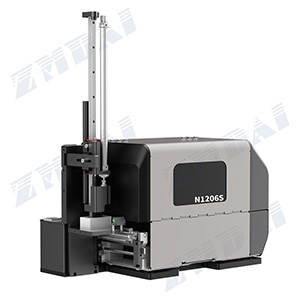Transitioning from manual labeling to automatic printing labeling machine
Edit: Click: Times Date:2024-7-19
With the continuous development of the automation industry today, there are also more and more enterprises engaged in independent innovation. Innovation is the new driving force for the continuous development of enterprises in the future. Especially with the continuous development of the automation industry in recent years, we have also seen that equipment in most production-oriented enterprises is constantly upgrading. For example, the common labeling process on the packaging assembly line of most production-oriented enterprises has also shifted from manual labeling to automatic printing labeling machines. For labeling equipment, it has been developing in the market for nearly 20 years. From manual, semi-automatic, and fully automatic at the beginning to intelligent support today, it has greatly improved the efficiency of product back-end packaging. According to the feedback of relevant responsible persons in production-oriented enterprises, the introduction of intelligent equipment has been found to have lower production costs than manual operations, bringing greater production efficiency and greatly reducing production costs.
Development History
1. Manual operation stage:
In the early days, the attachment of labels relied entirely on manual operation, and workers needed to attach the labels one by one to the products. This method is not only inefficient, but also difficult to ensure the quality of the attachment and prone to errors.
2. Mechanization stage:
In the 1930s, the first automatic labeling machine appeared, which used a rotating disc mechanism, greatly improving the speed and accuracy of label application. This labeling machine is suitable for mass production and widely used in industries such as food, pharmaceuticals, and cosmetics.
3. Electronic control stage:
In the 1960s, with the application of electronic control technology, the first electronically controlled labeling machine was introduced. It can not only automatically attach labels to products, but also adjust the labeling position according to the shape and size of the product, further improving production efficiency and accuracy.
4. Intelligence and automation stage:
In the 21st century, with the rapid development of computer technology and artificial intelligence, automatic printing and labeling machines have gradually achieved intelligence and automation. Computer controlled labeling machines can control the position, speed, and quantity of labels through preset programs, and can be linked with other production equipment to achieve efficient operation of automated production lines.

Current situation
1. Widely used:
At present, automatic printing and labeling machines have been widely used in production lines of various industries such as food and beverage, medicine, cosmetics, daily chemical, electronics, etc. They not only improve production efficiency, but also reduce labor costs, ensuring the accuracy and consistency of product labeling.
2. Technological innovation:
Modern automatic printing and labeling machines integrate high-precision printing technology, recognition technology, and automation technology, which can achieve full process automation from label printing to automatic labeling. At the same time, they also support labels in multiple formats and materials, which can meet the customized needs of different industries and customers.
3. Market growth:
With the advancement of industrial automation and intelligent manufacturing, the demand for automatic printing and labeling machines in the market continues to grow. Numerous domestic and foreign manufacturers have entered the market, and competition is becoming increasingly fierce. Enterprises need to continuously improve product quality and service levels, strengthen brand building and marketing.
Future Trends
1. Intelligence and automation:
In the future, automatic printing and labeling machines will become more intelligent and automated. By integrating advanced technologies such as artificial intelligence and the Internet of Things, they will be able to achieve self-learning, automatic adjustment, and optimization of the labeling process, improving production efficiency and labeling accuracy.
2. Multifunctionality:
The automatic printing and labeling machine will pay more attention to the design and development of multifunctionality. In addition to the basic labeling function, they will also have more additional functions, such as sealing and anti-counterfeiting functions for food packaging, to meet the special needs of different industries.
3. Energy conservation and environmental protection:
Against the backdrop of increasing global environmental awareness, automatic printing and labeling machines will pay more attention to energy conservation and environmental protection. The adoption of low-energy motors and the use of biodegradable materials will become industry trends.
4. Customized requirements:
With the increasing demand for personalized products from consumers, the automatic printing and labeling machine industry will face more customized needs. Enterprises need to provide flexible and diverse labeling solutions to meet the needs of different customers.
5. Digital transformation:
The automatic printing and labeling machine industry will undergo a digital transformation. The informatization, transparency, and intelligent management of the production process through digital technology will help improve production efficiency and quality levels.
【Next】
None!
 Mr.Li
Mr.Li +86-13925539874
+86-13925539874





